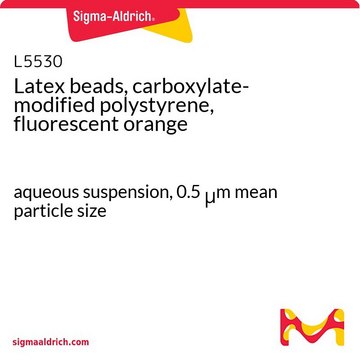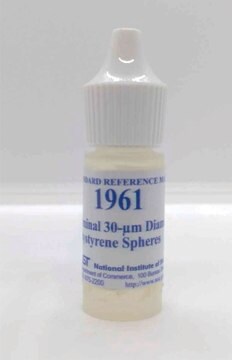LB8
Latex beads, polystyrene
0.8 μm mean particle size
Synonym(s):
Latex Beads, Latex Microspheres
Sign Into View Organizational & Contract Pricing
All Photos(1)
About This Item
Recommended Products
form
aqueous suspension
composition
Solids, 10%
packaging
pack of 1 mL
pack of 15 mL
pack of 2 mL
mean particle size
0.8 μm
Looking for similar products? Visit Product Comparison Guide
General description
Polystyrene microparticles are stabilizedcolloidal particles that possess a negative charge and are synthesized by thepolymerization of styrene under conditions that induce spontaneous coalescentbead formation. Due to their versatility, these beads can be used in antibody-mediatedagglutination diagnostics, electron microscopy, cell counter calibration, andphagocytosis experiments.
Application
Polystyrene latex beads have been used:
- inthe flow cytometric assay of endothelial microparticles (EMPs)
- in thedetection of capsular polysaccharide (CPS) antibody/antigen latex agglutinationtest
- to evaluate the phagocytic activity in hemocytes of shrimps
Storage Class Code
12 - Non Combustible Liquids
WGK
WGK 3
Flash Point(F)
Not applicable
Flash Point(C)
Not applicable
Choose from one of the most recent versions:
Already Own This Product?
Find documentation for the products that you have recently purchased in the Document Library.
Customers Also Viewed
Effects of traditional medical herbs ?minor bupleurum decoction? on the non-specific immune responses of white shrimp (Litopenaeus vannamei)
Yu-Sheng, et al.
Fish & Shellfish Immunology, 218-225, 84(1-842) (2017)
Joanna Koziel et al.
PloS one, 4(4), e5210-e5210 (2009-04-22)
It is becoming increasingly apparent that Staphylococcus aureus are able to survive engulfment by macrophages, and that the intracellular environment of these host cells, which is essential to innate host defenses against invading microorganisms, may in fact provide a refuge
Je-Wen Liou et al.
PloS one, 6(5), e19982-e19982 (2011-05-19)
Recent research shows that visible-light responsive photocatalysts have potential usage in antimicrobial applications. However, the dynamic changes in the damage to photocatalyzed bacteria remain unclear. Facilitated by atomic force microscopy, this study analyzes the visible-light driven photocatalyst-mediated damage of Escherichia
Our team of scientists has experience in all areas of research including Life Science, Material Science, Chemical Synthesis, Chromatography, Analytical and many others.
Contact Technical Service









